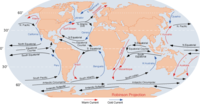
Photo from wikipedia
We study the evolution of large systems of sticky patches of pollution that float on the sea surface and are moved around by realistic wind and simulated surface currents. The… Click to show full abstract
We study the evolution of large systems of sticky patches of pollution that float on the sea surface and are moved around by realistic wind and simulated surface currents. The study area is the Gulf of Finland in the eastern Baltic Sea that hosts extremely heavy cargo and tanker traffic. It is assumed that patches merge at collision. Collisions are enhanced by wind impact that depends on the patch size. We implement a space partitioning algorithm for fast simulations of large systems of >8000 patches and perform a series of simulations with different initial size and location of the patches. The resulting empirical distribution of the number of patches of different size is governed universally by a stretched-exponential power law f(x) = A exp (-xb). This indicates that the evolution of large systems of pollution patches on the sea surface exhibits classic self-organization and scale invariance properties. This may be the key effect explaining how the patchiness of waste in marine environment is formed under the impact of different drivers.
Journal Title: Marine pollution bulletin
Year Published: 2019
Link to full text (if available)
Share on Social Media: Sign Up to like & get
recommendations!